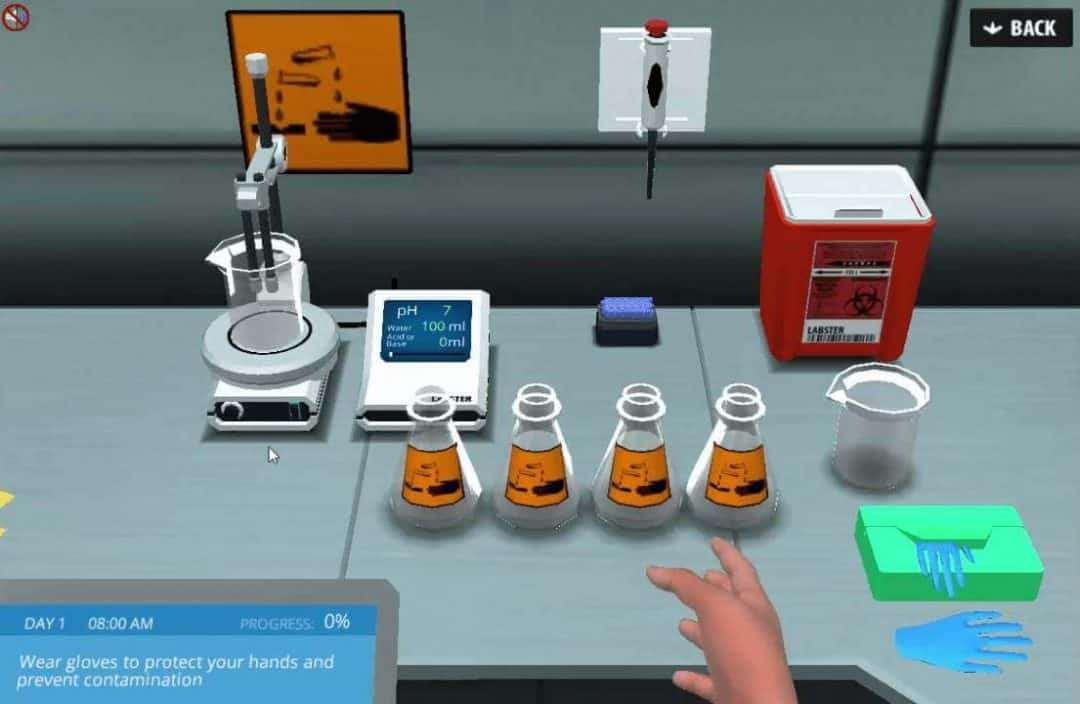Heading 1
Heading 2
Heading 3
Heading 4
Heading 5
Heading 6
Lorem ipsum dolor sit amet, consectetur adipiscing elit, sed do eiusmod tempor incididunt ut labore et dolore magna aliqua. Ut enim ad minim veniam, quis nostrud exercitation ullamco laboris nisi ut aliquip ex ea commodo consequat. Duis aute irure dolor in reprehenderit in voluptate velit esse cillum dolore eu fugiat nulla pariatur.
Block quote
Ordered list
- Item 1
- Item 2
- Item 3
Unordered list
- Item A
- Item B
- Item C
Bold text
Emphasis
Superscript
Subscript
About This Simulation
Learn about lab safety, scientific methods, diffusion and osmosis, acids, bases and how to prepare buffers.
Learning Objectives
- Understand the basics of safety in the laboratory
- Calculate pH of strong acids, weak acids, strong bases and weak bases
- Understand how acid dissociates in water
- Understand the principle of diffusion and osmosis
- Understand the different blood type groups and how to perform blood type test
About This Simulation
Lab Techniques
- Blood Typing
- pH determination
- Light microscopy
Related Standards
- Support for laboratory skills at all levels
- Generic support for fume hood use, lab safety and good scientific practice
- Generic experimental design support
- Generic technical support for practical skill development
Learn More About This Simulation
In the Introductory lab, you will learn about acids and bases, the concepts of diffusion and osmosis, and blood typing. Try out this lab and become an expert in risk evaluation in the laboratory!
Learn about acids and bases
Your first task is to mix acid/base with water. Watch a 3D animation to see how it dissociates to produce [H3O+] or [OH-]. You will learn how to calculate pH depending on if it is a strong acid/base or a weak acid/base. You will be introduced to the concept of acid dissociation constant (Ka) and base dissociation constant (Kb).
Diffusion and osmosis
Diffusion and osmosis are two fundamental concepts in biotechnology that are also important in daily life. In the Introductory lab, you will learn the difference between diffusion and osmosis. Observe under the microscope how cells adapt to hypotonic or hypertonic environments based on the principle of osmosis. You will learn that environments are dynamic by e.g. seeing that cells that are already swollen can be reverted back to normal by adding hypertonic solution.
Conduct a blood test experiment
In the introductory lab, you will also conduct a blood type test experiment. You will be presented with a patient that is in desperate need of a blood transfusion. To help the patient, you will first learn about the different blood type groups (both ABO and Rh) and the consequences of incompatible blood transfusions, and then you will use a typical blood type test card to determine the blood group. By observing the results, whether the sample clots or not, you will be able to draw a conclusion and determine the blood group.
Will you be able to save the patient with your newly acquired knowledge?
Boost STEM Pass Rates
Boost Learning with Fun
75% of students show high engagement and improved grades with Labster
Discover Simulations That Match Your Syllabus
Easily bolster your learning objectives with relevant, interactive content
Place Students in the Shoes of Real Scientists
Practice a lab procedure or visualize theory through narrative-driven scenarios


For Science Programs Providing a Learning Advantage
FAQs
Find answers to frequently asked questions.
Heading 1
Heading 2
Heading 3
Heading 4
Heading 5
Heading 6
Lorem ipsum dolor sit amet, consectetur adipiscing elit, sed do eiusmod tempor incididunt ut labore et dolore magna aliqua. Ut enim ad minim veniam, quis nostrud exercitation ullamco laboris nisi ut aliquip ex ea commodo consequat. Duis aute irure dolor in reprehenderit in voluptate velit esse cillum dolore eu fugiat nulla pariatur.
Block quote
Ordered list
- Item 1
- Item 2
- Item 3
Unordered list
- Item A
- Item B
- Item C
Bold text
Emphasis
Superscript
Subscript
Labster can be integrated within a school's LMS (Learning Management System), and students can access it like any other assignment in their LMS. If your Institution does not choose an LMS integration, students will log in to Labster's Course Manager once they have an account created. Your institution will decide the access method during the sales process.
Labster is available for purchase by instructors, faculty, and administrators at education institutions. Purchasing our starter package, Labster Explorer, can be done using a credit card if you are located in the USA, Canada, or Mexico. If you are outside of North America or are choosing a higher plan, please speak with a Labster sales representative. Compare plans.
Labster simulations are created by real scientists and designed with unparalleled interactivity. Unlike point and click competitors, Labster simulations immerse students and encourage mastery through active learning.
Labster supports a wide range of courses at the high school and university level across fields in biology, chemistry and physics. Some simulations mimic lab procedures with high fidelity to train foundational skills, while others are meant to bring theory to life through interactive scenarios.


















